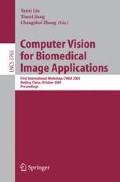Abstract
In this paper we present a fully automatic and accurate segmentation framework for 2D tagged cardiac MR images. This scheme consists of three learning methods: a) an active shape model is implemented to model the heart shape variations, b) an Adaboost learning method is applied to learn confidence-rated boundary criterions from the local appearance features at each landmark point on the shape model, and c) an Adaboost detection technique is used to initialize the segmentation. The set of boundary statistics learned by Adaboost is the weighted combination of all the useful appearance features, and results in more reliable and accurate image forces compared to using only edge or region information. Our experimental results show that given similar imaging techniques, our method can achieve a highly accurate performance without any human interaction.
Access this chapter
Tax calculation will be finalised at checkout
Purchases are for personal use only
Preview
Unable to display preview. Download preview PDF.
References
Montillo, A., Metaxas, D., Axel, L.: Automated segmentation of the left and right ventricles in 4d cardiac spamm images. In: Medical Imaging Computing and Computer-Assisted Intervention, pp. 620–633 (2002)
Huang, X., Li, Z., Metaxas, D.N.: Learning coupled prior shape and appearance models for segmentation. In: Barillot, C., Haynor, D.R., Hellier, P. (eds.) MICCAI 2004. LNCS, vol. 3216, pp. 60–69. Springer, Heidelberg (2004)
Qian, Z., Huang, X., Metaxas, D., Axel, L.: Robust segmentation of 4d cardiac mri-tagged images via spatio-temporal propagation. In: Proceedings of SPIE Medical Imaging: Physiology, Function, and Structure from Medical Images, vol. 5746, pp. 580–591 (2005)
Metaxas, D., Chen, T., Huang, X., Axel, L.: Cardiac segmentation from mri-tagged and ct images. In: 8th WSEAS International Conf. on Computers, special session on Imaging and Image Processing of Dynamic Processes in biology and medicine (2004)
Ginneken, B.V., Frangi, A.F., Staal, J.J., et al.: Active shape model segmentation with optimal features. IEEE Trans. on Medical Imaging 21 (2002)
Jiao, F., Li, S., Shum, H., Schuurmans, D.: Face alignment using statistical models and wavelet features. In: IEEE Conf. on CVPR, vol. 1, pp. 321–327 (2003)
Li, S., Zhu, L., Jiang, T.: Active shape model segmentation using local edge structures and adaboost. In: Medical Imaging Augmented Reality (2004)
Cootes, T., Taylor, C., Cooper, D., Graham, J.: Active shape models - their training and application. Computer Vision and Image Understanding 61, 38–59 (1995)
Daugman, J.: Uncertainty relation for resolution in space, spatial frequency, and orientation optimized by two-dimensional visual cortical filters. Journal of the Optical Society of America A 2, 1160–1169 (1985)
Freund, Y., Schapire, R.E.: A decision-theoretic generalization of on-line learning and an application to boosting. In: Vitányi, P.M.B. (ed.) EuroCOLT 1995. LNCS, vol. 904, pp. 23–37. Springer, Heidelberg (1995)
Schapire, R.E.: The boosting approach to machine learning: An overview. In: MSRI Workshop on Nonlinear Estimation and Classification (2002)
Schapire, R.E., Freund, Y., Bartlett, P.L., Lee, W.S.: Boosting the margin: a new explanation for the effectiveness of voting methods. Annals of Statistics 26, 1651–1686 (1998)
Viola, P., Jones, M.: Robust real-time object detection. In: Second International Workshop on Statistical and Computational Theories of Vision - Modeling, Learning, And Sampling, Vancouer, Canada (July 13, 2001)
Author information
Authors and Affiliations
Editor information
Editors and Affiliations
Rights and permissions
Copyright information
© 2005 Springer-Verlag Berlin Heidelberg
About this paper
Cite this paper
Qian, Z., Metaxas, D.N., Axel, L. (2005). A Learning Framework for the Automatic and Accurate Segmentation of Cardiac Tagged MRI Images. In: Liu, Y., Jiang, T., Zhang, C. (eds) Computer Vision for Biomedical Image Applications. CVBIA 2005. Lecture Notes in Computer Science, vol 3765. Springer, Berlin, Heidelberg. https://doi.org/10.1007/11569541_11
Download citation
DOI: https://doi.org/10.1007/11569541_11
Publisher Name: Springer, Berlin, Heidelberg
Print ISBN: 978-3-540-29411-5
Online ISBN: 978-3-540-32125-5
eBook Packages: Computer ScienceComputer Science (R0)

